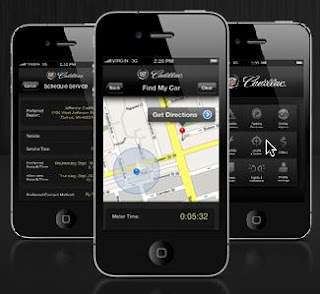An app is different than a mobile website in that it can interact with a cell phone's functionality.
Example: the Facebook App uses GPS in a phone to automatically add a user's location to a status update.
If you want a closer look at the differences between a Mobile Website and a Mobile App, check out our Internet 101 blog post.
Establish Your Goals
The key to a successful app is one that enables your users to do something related to your brand quickly and easily.When creating your Mobile Strategy, ask yourself what process you can simplify by allowing users to connect to their cell phone's functionality. No matter the brand of phone, there are a number of functions that are shared by all. Let's discuss them and how they can be used as part of an effective app.
GPS
 Check out the MyCadillac app for a great example of integrating an app with GPS functionality. The MyCadillac app will remember where you parked the car and if it's time to add money to the meter. Also, when it's time for service, you can search for the nearest dealer by your current location.
Check out the MyCadillac app for a great example of integrating an app with GPS functionality. The MyCadillac app will remember where you parked the car and if it's time to add money to the meter. Also, when it's time for service, you can search for the nearest dealer by your current location.There is no need to stop just at GPS integration, however. Note that, in addition to these GPS-related features, the app also contains relevant information for the user, such as the car's owner's manual, a lights and indicators guide, and access to their OnStar service.
The takeaway:
Cadillac created an app that would make life easier for their drivers. By recalling parking locations and finding a service dealer, the app is entirely appropriate and usable.
Touch
While virtually all apps incorporate touch to navigate, few harness the power of touch like Tiffany & Co. Tiffany noticed the growing numbers of mobile sales coming through their online story. Their reaction to it was to create a beautiful, robust tool to help in the engagement ring selection process.
In an effort to help obtain accurate ring-size, users can place an actual ring directly on the screen and align it with the correct circle in the guide. In addition, the rings are shown true-to-size and can be rotated, zoomed in on and swapped out with different carat sizes.
The takeaway:
Tiffany & Co. worked to bring the experience of shopping in-store for an engagement ring to users' cell phones. The design of the app exudes Tiffany's quality and eye for design. Finally, the app solves a major problem of shopping online--obtaining an accurate ring size. They made shopping simple and easy.
Audio/Visual
App users can scan the bar codes of their prescriptions to order refills or transfer their script to a Walgreens store. In addition, photo processing is made a painless process. Photos on a phone can be enhanced through their photo filters and then added to the cart and ordered to be printed at the nearest Walgreens store. All of these actions are made possible by the phone's camera.
The takeaway:
The app has some additional features as well, but the takeaway here is how Walgreens has taken two of their core business functions and made them easy for their customers. The app looks to save the amount of time a person would have to spend physically in the store.
Contacts
Google Voice allows you to read voicemail like a text message, which can be handy when you're trying to be discreet. Also, you can send text messages and create custom greetings based on who is calling you.
Google Voice connects with your contacts to seamlessly create a Google-fied phone experience.
The takeaway:
Using existing contact data, Google creates a bigger, smarter experience on a user's cell phone.
Portability
For better or worse, our cell phones are with us wherever we go--the store, the bedroom and the bathroom even! These devices are also conveniently with us throughout the entire buying process--as we ponder, weigh, analyze and, eventually, purchase any item.
Target looks to assist buyers at varying places within the buying process. From a Daily Deals alert service, to a baby registry, barcode scanner, and shopping list creator, they've made a user's phone an essential asset throughout the buying process.
The takeaway:
Target worked to meet buyers where they are at throughout the buying process. Whether they're interested in deals, creating lists or wish lists, there's an app for each need.
Creating Your To-Do List
It's time to set out to create a great-app that will benefit your brand and your customers.
A great app will:
make life easier be appropriate and usable bring the experience of shopping in-store to users' cell phones take core business functions and make them easy for their customers create bigger, smarter experience meet buyers where they are at
For your mobile strategy, strive to do one central thing and make it easy for your users.
- What need can you satisfy?
- What process can you simplify?
- What aspect can you enhance?
- What information are your customers looking for?
The examples above merely scratch the surface of app integration. Remember to be creative and put yourself in your customer's shoes. Happy Apping!




